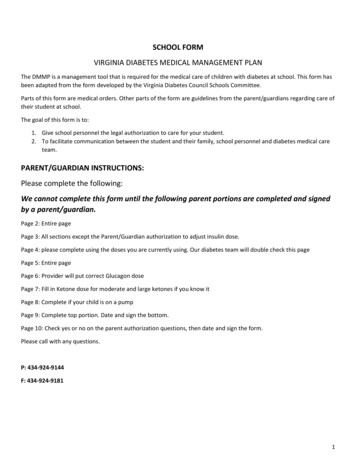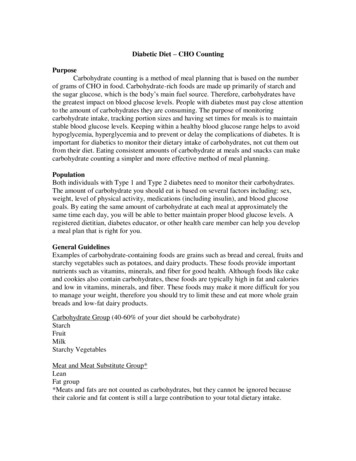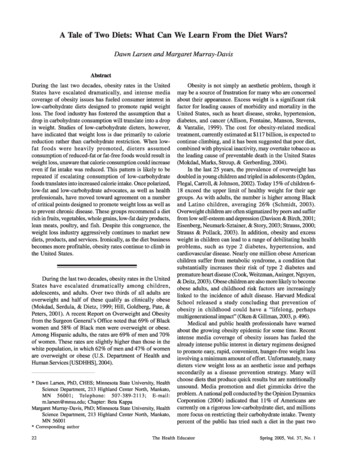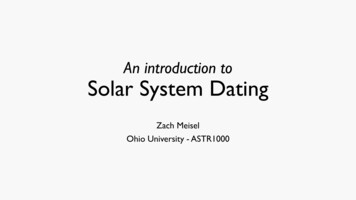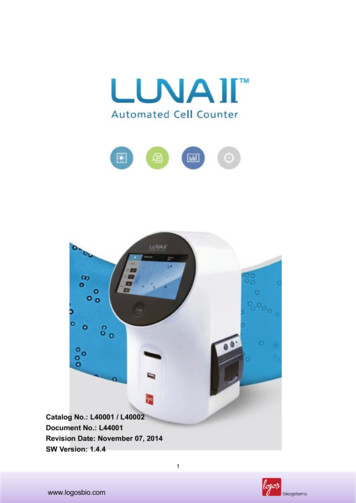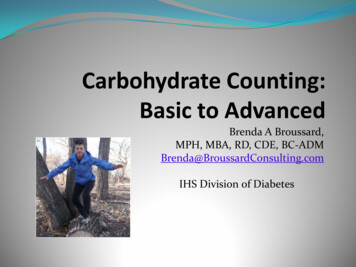
Transcription
Carbohydrate Counting:Basic to AdvancedBrenda A Broussard,MPH, MBA, RD, CDE, BC-ADMBrenda@BroussardConsulting.comIHS Division of Diabetes
Outline: Carb Awareness Basic/Consistent AdvancedIHS Division of Diabetes 20132
Counting “Carbs” Carbs in Honey Bun? g Carbs in 1 block package ofRamen? g Favorite foods with Carbs? Carb Counting Resources:IHS Division of Diabetes 20133
Carbohydrate Counting MNT works! One of many meal planningapproaches Carbs - Up BG Continuum - Individualized Carb Awareness Basic – Consistent Carbohydrates Advanced – Carb/Insulin RatioFranz MJ, et al., J Am Diet Assoc. 2004;104:1805-15.Standards of Medical Care in Diabetes - 2013. Diabetes Care.American Diabetes Association Guide to Nutrition Therapy forDiabetes. 2012.IHS Division of Diabetes 20134
Assessment A1C target met? SMBG? Typical meal pattern Medications? Health literacy & numeracy Meal planning approach? Introduce concept of carbohydratecounting Establish carbohydrate target rangesIHS Division of Diabetes 20135
Factors Influencing BG Amount of carbohydrates High fat foods/meals Incorrect insulin dose/missed dose Other medications Injection site Physical activity Stress Illness IHS Division of Diabetes 20136
Healthy Eating –General Recommendations Choose healthy ed fats Set an eating schedule,i.e., Eat 3 small-to-mediumsized meals; includesome carbs/meal Avoid “liquid sugar” Meal plans to consider IHS Division of Diabetes 20137
Carb Awareness Identify foods that do and do not contain carbsA Controlled Carb meal plan not aLow Carb meal planRDA 130 g/day ( 9 choices)Average adult carb intake %Kcal?Individualize the amount of carb formeals and snacks/dayEstimate accurately amount of carbsin food servingsDCCT, Look AHEAD, NHANEShttp://ndb.nal.usda.gov/ndb/search/listIHS Division of Diabetes 20138
What foods have carbohydrates? Breads, cereals, and grains Starchy vegetables Dried beans and lentils Fruits Milk and yogurt Sweets, desserts, regular sodaIHS Division of Diabetes 20139
What foods have little orno carbohydrates? Non-starchy vegetables Meat, poultry, fish, eggs, cheese, soy/meat substitutes Fats/oilsIHS Division of Diabetes 201310
Plate Method – Carb te1 508c.pdfFor people who: Are less active Are older Need to eat less caloriesAt meals, keep rice, beans,pasta, and starchy veggies toone-fourth of a place, add oneserving fruit, and/or oneserving milk/yogurtCamelon KM, et al. The Plate Method. J Am Diet Assoc.1998;98(10):1155-8IHS Division of Diabetes 201311
Plate Method – Carb Awareness 1 508c.pdfFor people who: Are active Are younger Want to stay at same weightAt meals, keep rice, beans,pasta, and starchy veggies toone-half of a plate, add oneserving fruit, and/or oneserving milk/yogurtIHS Division of Diabetes 201312
IHS DDTP es/RESOURCES/Catalog/index.cfmIHS Division of Diabetes 201313
How do you count carbs? Count grams ofcarbohydrate Count carb choices(“servings”, “exchanges”) To determine amount: Weigh and measure with portioncontrol tools Ask patients to measure portionsusing their plates, bowls, & glasses Use food models as a teaching tool15 grams 1 carb choice Reliable websites: Calorie Kingwww.calorieking.com USDA NutrientDatabasehttp://ndb.nal.usda.govIHS Division of Diabetes 201314
1 Carb Choice 15 g. CarbohydratesFood GroupServing SizeBread, cereal1 slice, ¾ cup unsweetenedPasta, rice1/3 cupStarchy veg – potato, corn, beans½ cupFruit1 small piece, ½ cup cannedMilk & plain yogurt1 cupSweets/snack foods2 small sandwich cookies, ½ cup ice cream, 15snack chips, 1 tbsp. jellyNonstarchy vegetables3 cups raw (salad), 1 ½ cups cookedIHS Division of Diabetes 201315
Basic/Consistent CarbohydrateIntake Emphasize day-to-dayconsistency General Targets Premeal 70-130 mg/dL 2 postmeal 180 mg/dL Improve glycemic controlthrough managingpatterns of BG as theyrelate to food intake,diabetes medication, andphysical activity.IHS Division of Diabetes 2013 Client willing to keep food,BG, physical activityrecords Client willing toweigh/measure foodportions Educator teaches: carbohydrate grams orchoices portion sizes BG/food/activity patterns16
General Guidelines: Carbs/MealWomenMen To lose weight 30-45 g To maintain weight 45-60 g For very active 60-75 g Snacks: 15-30 g To lose weight 45-60 g To maintain weight 60-75 g For very active 60-90 g Snacks: 15-30 gIndividualizeIndividualizeIHS Division of Diabetes 201317
Reading Nutrition Facts LabelFind the serving size –compare to actualportion eaten2. Find Total Carbohydrate*3. Count grams of carbs orcarb choices 1 cup 31 g. carbohydrateor 1 cup 2 carb choices1. *Dietary fiber, sugars,sugar alcohols included inTotal CarbohydrateIHS Division of Diabetes 201318
Basic Patient EducationResourcesHealthy Food Choices, 3rd Edition. Mini-poster.American Diabetes y-foodchoices-25pk.aspxAADE7 Self-Care Behaviors: Healthy Eating2-page download; available de/ resources/pdf/general/AADE7 healthy eating.pdfMy Food Plan Made Easy, 2nd Edition.International Diabetes de-Easy/productinfo/2058-MFPE/IHS Division of Diabetes 201319
Patient Education ResourcesMy Food Plan.My Food Plan for Gestational Diabetes.4-fold with 8 panels, carb counting guide.Carbohydrate Counting. 31p booklet.International Diabetes Center.http://www.idcpublishing.comReady, Set, Start Counting:Carbohydrates Counting.3-page download. Free. DCE tionhandouts/#edGrocery Store TourCustomized collection of nutrition factslabels (laminated) in a 3-ring binder.IHS Division of Diabetes 201320
Mobile AppsGoMeals.comwww.mynetdiary.comMyNetDiary Diabetes Tracker AppIHS Division of Diabetes 201321
Top Rated Apps by PatientsApple AppAndroid App Calorie Counter byMyFitnessPal Calorie King Calorie Counter byMyNetDiary Calorie Counter byMyFitnessPal Diet and Calorie Tracker bySparkpeople Calorie Counter by FatSecretGilgen E. Smartphone apps to help with diabetesmanagement. AADE in Practice. 2012 Fall:6.IHS Division of Diabetes 201322
Advanced Carbohydrate Counting Match fast-acting insulindoses to carb intake basedon carb-to-insulin ratiosand correction factors 31% - insulin therapy(2012 IHS DM audit) Understand BG targets Accurately count carbs Willingness/ability to keepfood, activity, insulin, BGlogs See BG patterns, makeadjustments Multiple visits,reinforcement, ongoingsupport from DM teamWarshaw HS, Kulkarni K. Complete Guide to CarbCounting. 2011.IHS Division of Diabetes 201323
Carb-to-Insulin Ratio Helps determine bolus dose of fast-acting insulin to“cover” the carbs at a meal or snack. Total grams of carbs disposed by X unit(s) of insulin# g carb # units bolus insulin g carb/1 unit insulinIHS Division of Diabetes 201324
Determine Carb:Insulin RatioQuick and Easy Method2. Pattern Management3. Rule of 500 or Rule of 4501.UC San Francisco Diabetes Teaching 50IHS Division of Diabetes 201325
Determine Carb:Insulin RatioQuick and Easy Method# g carb # units bolus insulin g carb/1 unit insulin Starting ratios: 15:1 (15 g carb for 1 unit fast-acting insulin) Ratios vary 10:1 (insulin resistant/obese)20:1 (young, thin)IHS Division of Diabetes 201326
Determine Carb:Insulin RatioPattern Management Review food, insulin, and BG records (3-7 days) Identify trends Gram Method Carb (g) X units bolus insulin g carb/1 UI Case Study: Usually eats 70 grams Carb for dinner, andhe takes 7 units insulin70 g carb 7 units insulin 10:1 (carb:insulin ratio)10 g. carb covered by 1 unit insulinIHS Division of Diabetes 201327
Determine Carb: Insulin Ratio500 and 450 Rule (Type 1)Walsh J, Roberts R. The Pocket Pancreas, 2000500 (450) total daily dose (TDD) of fast-acting insulinCase Study: Total daily dose is 50 units rapid-acting insulin 500 50 10 g carb covered by 1 unit rapid-acting insulin 10:1IHS Division of Diabetes 201328
Carb: Insulin RatioCase Study:BreakfastLunchDinner10:115:115:1Lunch: Cheeseburger (35 g)small salad (4 g)vinaigrette dressing (3 g)1 chocolate chip cookie (21 g)diet soda (0 g)Total carbs for lunch? g.How much insulin should she take before lunch? unitsIf BG out of target range: If 2 hr PPG is too high – decrease ratio: less carb/unit insulin Go from 15:1 ratio to 10:1 ratio If 2 hr PPG is too low – increase ratio: more carb/unit insulin Go from 15:1 ratio to 20:1 ratioIHS Division of Diabetes 201329
Carb:Insulin RatioIHS Division of Diabetes 201330
What is an Insulin CorrectionFactor? Used to calculate theamount of bolus insulinto bring BG into targetrange This adjusts or corrects aBG that is higher orlower than desiredbefore a meal Ex: 1 unit of insulin todrop BG by 50 mg/dL General BG RangeTargets Pre-meal 70-130 mg/dL Post-meal 180 mg/dL(2 hours after first bite)ADA Clinical PracticeRecommendations, 2013 IndividualizeIHS Division of Diabetes 201331
Using Insulin Correction FactorCurrent Blood Glucose – Target Blood GlucoseInsulin Correction Factor (X points)Case Study:Assume 1 unit will drop blood glucose 35 points (insulincorrection factor)Pre-meal BG 190 mg/dLTarget BG 120 mg/dLInsulin correction dose difference between the actual BGminus target BG divided by the correction factor190 mg/dL – 120 mg/dL 70 35 2 units of insulin35IHS Division of Diabetes 201332
Total Mealtime Insulin DoseCase Study:Plan to eat 60 g of carb.Carb:insulin ratio is 10:1 (10 g. carb covered by 1 unit of insulin)60 g. carb 10 6 units of insulin needed for this amount of carbsAnd assume 1 unit will drop blood glucose 35 points (insulin correction factor)Pre-meal BG 190 mg/dLTarget BG 120 mg/dLInsulin correction dose difference between the actual BG minus target BG divided by thecorrection factor190 mg/dL – 120 mg/dL 70 35 2 units of insulin356 units (carbohydrate coverage dose) 2 units (BG correction dose)Total Mealtime Insulin Dose 8 unitsIHS Division of Diabetes 201333
Mealtime Insulin Dosing:Simple Algorithm vs. Carb 07.88.1Carb Count50.550.5100.98.3At 24 Weeks BasalBolusTDDA1CWeightGain (lb.)Algorithm108.7102.5207.46.77.9Carb Count88.986.4175.56.55.3Bergenstal RM, et al. Adjust to target in type 2 diabetes.Diabetes Care. 2008 Jul;31(7):1305-10IHS Division of Diabetes 201334
Bergenstal RM, et al. Diabetes Care.2008 Jul;31(7):1305-10Basal Insulin AdjustmentsIHS Division of Diabetes 201335
Bolus Insulin Pattern of mealtime BGbelow targetPattern of mealtime BGabove target 10 unitsDecrease by 1 unitIncrease by 1 unit 11-19 unitsDecrease by 2 unitsIncrease by 2 units 20 unitsDecrease by 3 unitsIncrease by 3 unitsMealtime dose Pattern of mealtime BGbelow targetPattern of mealtime BGabove target1 unit/20 gDecrease to 1 unit/25 gIncrease to 1 unit/15 g1 unit/15 gDecrease to 1 unit/20 gIncrease to 1 unit/10 g1 unit/10 gDecrease to 1 unit/15 gIncrease to 2 units/15 g2 units/15 gDecrease to 1 unit/10 gIncrease to 3 units/15 g3 units/15 gDecrease to 2 units/15 gIncrease to 4 units/15 gBergenstal RM, et al. Diabetes Care. 2008 Jul;31(7):1305-10IHS Division of Diabetes 201336
Resources for Intensive TherapyComplete Guide to Carb Counting.3rd Edition. 2011, 169 pages. American Diabetes AssociationBlood Glucose Pattern Control: A Guide for PeopleWho Use Insulin.3rd Edition. 36 pages. International Diabetes CenterIHS DDTP When and How to Use Insulin Therapy in Type 2Diabetes. Richard M Bergenstal, MD (podcast) Advanced Strategies for Diabetes Management:Case Presentations. JoEllen Habas, MD (recordedseminar) Individualizing Diabetes Targets: One Size DoesNot Fit All. Ann Bullock, MD (Advancements webinar) Update on Self-Monitoring Blood Glucose. MarieRussell, MD MPH (Advancements webinar) Nutrition for Diabetes Prevention & Care (BestPractice)IHS Division of Diabetes 201337
Carbohydrate Counting:Basic to AdvancedOutline Carb Awareness Basic/Consistent AdvancedBrenda A BroussardBrenda@BroussardConsutling.comWishing you muchsuccess!IHS Division of Diabetes 201338
Carbohydrate Counting: Basic to Advanced Brenda A Broussard, MPH, MBA, RD, CDE, BC-ADM . Brenda@BroussardConsulting.com . IHS Division of Diabetes
